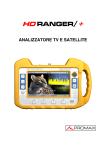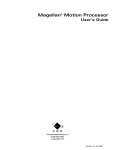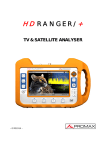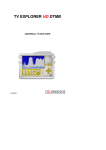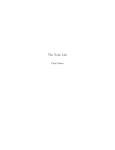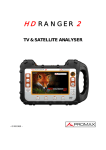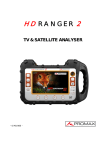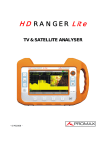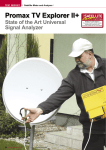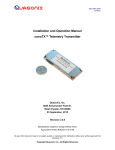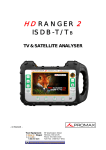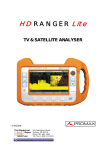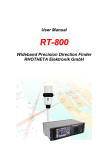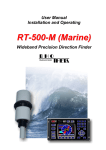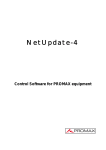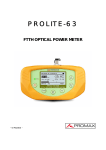Download full Spec Sheet
Transcript
HD RANGER/+ TV & SATELLITE ANALYSER - 0 MI1914 - SAFETY NOTES Read the user’s manual before using the equipment, mainly " SAFETY RULES " paragraph. on the equipment means "SEE USER’S MANUAL". In this manual The symbol may also appear as a Caution or Warning symbol. WARNING AND CAUTION statements may appear in this manual to avoid injury hazard or damage to this product or other property. INFORMATION NOTE This is a preliminary version of the RANGER/+ user manual. This version may change according to new equipment updates or by corrections or suggestions for improvement. SAFETY RULES * The safety could not be assured if the instructions for use are not closely followed. * Use this equipment connected only to systems with their negative of measurement connected to ground potential. * The AL-103 external DC charger is a Class I equipment, for safety reasons plug it to a supply line with the corresponding ground terminal. * This equipment can be used in Overvoltage Category I installations and Pollution Degree 2 environments. External DC charger can be used in Overvoltage Category II, installation and Pollution Degree 1 environments. * When using some of the following accessories use only the specified ones to ensure safety.: Rechargeable battery External DC charger Car lighter charger cable Power cord * Observe all specified ratings both of supply and measurement. * Remember that voltages higher than 70 V DC or 33 V AC rms are dangerous. * Use this instrument under the specified environmental conditions. * When using the power adaptor, the negative of measurement is at ground potential. * Do not obstruct the ventilation system of the instrument. * Use for the signal inputs/outputs, specially when working with high levels, appropriate low radiation cables. * Follow the cleaning instructions described in the Maintenance paragraph. * Symbols related with safety: Descriptive Examples of Over-Voltage Categories Cat I Low voltage installations isolated from the mains. Cat II Portable domestic installations. Cat III Fixed domestic installations. Cat IV Industrial installations. TABLE OF CONTENTS SAFETY RULES ................................................................................................. 1 Descriptive Examples of Over-Voltage Categories ........................................... 2 1 INTRODUCTION ......................................................................................... 1-1 1.1 Description....................................................................................... 1-1 2 SETTING UP .............................................................................................. 2-3 2.1 Package Content ............................................................................. 2-3 2.2 Power ............................................................................................ 2-4 2.2.1 First charge................................................................................. 2-4 2.2.2 Charging the battery .................................................................... 2-4 2.2.3 Charge / discharge times .............................................................. 2-5 2.2.4 Smart control battery ................................................................... 2-5 2.2.5 Usage Tips .................................................................................. 2-6 2.3 Equipment Details ........................................................................... 2-7 2.4 Switching On / Off the equipment ...................................................... 2-9 2.5 Screen Icons and Dialog boxes ........................................................ 2-10 2.6 Menu Tree .................................................................................... 2-11 2.7 Controls ....................................................................................... 2-14 2.7.1 Joystick .................................................................................... 2-14 2.7.2 Keyboard shortcuts .................................................................... 2-15 2.7.3 Softkeys ................................................................................... 2-19 3 MEASUREMENT MODE .............................................................................. 3-20 3.1 Introduction ................................................................................... 3-20 3.2 Operation ...................................................................................... 3-21 4 SPECTRUM ANALYSER MODE ..................................................................... 4-24 4.1 Introduction.................................................................................. 4-24 4.2 Mode of operation.......................................................................... 4-24 4.3 Description of the FULL SPECTRUM screen......................................... 4-28 4.4 JOYSTICK Operation in SPECTRUM ANALYSER mode. .......................... 4-29 4.5 Options Menu................................................................................ 4-30 4.5.1 F1: Tuning ................................................................................ 4-31 4.5.2 F2: Signal Parameters ................................................................ 4-33 4.5.3 F3: Tools .................................................................................. 4-33 4.5.4 F4: Advanced ............................................................................ 4-34 4.6 Location of a signal with the SPECTRUM ANALYZER ............................ 4-35 5 TV MODE ................................................................................................ 5-36 5.1 Introduction.................................................................................. 5-36 5.2 Operation ..................................................................................... 5-36 5.3 Menu Options................................................................................ 5-40 5.3.1 ANALOGUE signal ...................................................................... 5-40 5.3.2 Terrestrial / Satellite Digital Signal ............................................... 5-40 5.3.2.1 F1: Number of Channel / Frequency tuned. ................................ 5-40 5.3.2.2 F2: Standard of the tuned signal............................................... 5-40 5.3.2.3 F3: Selected service name. ...................................................... 5-41 5.3.2.4 F4: Language of the selected service. ........................................ 5-41 August 2012 6 TOOLS ................................................................................................... 6-42 6.1 Constellation .................................................................................. 6-42 6.1.1 Description .................................................................................. 6-42 6.1.2 Operation .................................................................................... 6-42 6.1.3 Menu Options .............................................................................. 6-44 6.2 LTE Ingress test.............................................................................. 6-44 6.2.1 Description .................................................................................. 6-44 6.2.2 Operation .................................................................................... 6-45 6.2.3 Options Menu .............................................................................. 6-46 6.3 Echoes .......................................................................................... 6-47 6.3.1 Description .................................................................................. 6-47 6.3.2 Operation .................................................................................... 6-47 6.3.3 Menu Options .............................................................................. 6-49 6.4 Installations Management ................................................................ 6-49 6.5 Installation Manager ........................................................................ 6-50 7 SPECIFICATIONS ..................................................................................... 7-53 7.1 Specifications HD RANGER+............................................................ 7-53 7.2 Specifications HD RANGER .............................................................. 7-61 8 MAINTENANCE ........................................................................................ 8-67 8.1 Considerations about the Screen ....................................................... 8-67 8.2 Cleaning Recommendations .............................................................. 8-67 ANNEX 1 SIGNALS DESCRIPTION ....................................................................... 1 August 2012 TV & SATELLITE ANALYSER HD RANGER/+ 1 1 INTRODUCTION 1.1 Description The new HD RANGER/+ is the fifth generation of field meters that PROMAX launches. As each new generation, it represents an evolution from the previous, since it integrates the latest technological innovations and develops applications for the new demands and needs that have emerged in recent years. The new HD RANGER/+ has been created with the aim to make easy the user experience. From its ergonomic design and stylized lines to the reduction of keys and the easy use of its interface, everything has been designed so the user has a simple tool to use but powerful and useful. Figure 1. The HD RANGER/+ is a universal field meter that covers TV standards of the DVB family, as well as formats such as MPEG-2 or MPEG-4 and Dolby audio. There is also the possibility of an extension to work in fibre optics installations. 1 Trademark of the DVB - Digital Video Broadcasting Project. August 2012 1-1 Besides the basic functions of TV meter and spectrum analyser for terrestrial and satellite band, it provides additional tools, such as the detection of 4G signal interferences (some of its working frequencies are close to the TV bands), the diagrams constellations or the echoes detection.. The HD RANGER/+ has an application to manage data generated at each installation.This feature helps the user to manage information generated so he can access it at any time or download it to a PC for further analysis. The HD RANGER/+ has been designed and developed entirely in the European Union. A multidisciplinary team of highly qualified professionals has dedicated effort and commitment to the development of a powerful, efficient and reliable tool. During the manufacturing process, all used materials have been subjected to a strict quality control. In an effort to facilitate its work to professionals, our long experience ensures an after sales quality service, which includes updates and upgrades for free. Figure 2. 1-2 August 2012 2 SETTING UP 2.1 Package Content Check that your package contains the following elements: HD RANGER/+ Field Meter. External DC charger. Mains cord for external DC charger. Car lighter charger. "F" Adapters (3 units). • "F" / H - BNC / H Adapter. • "F" / H - DIN / H Adapter. • "F" / H - "F" / H Adapter. Support belt and carrying bag. USB On-the-go (A) Male - Mini USB (B) Male. USB cable (A) Male - Mini USB (B) Male. 4V / RCA Jack Cable. Transport suitcase *. Quick Start Guide. NOTE: Keep the original packaging, since it is specially designed to protect the equipment. You may need it in the future to send the meter to be calibrated. * Supplied only with the HD RANGER + model. Optional Accessory on request for HD RANGER. August 2012 2-3 2.2 Power The HD RANGER/+ is powered by a 7.2 V built-in rechargeable Li-Ion battery of high quality and long duration. The equipment can operate on battery or connected to the network using a DC adapter. An adapter is also supplied to use with the power connector car (cigarette lighter). 2.2.1 First charge The equipment comes with the battery fully charged. Depending on the time elapsed from first charge and environmental conditions may have lost some of the charge. Check the battery level. 2.2.2 Charging the battery Connect the DC power adapter (2) to the equipment through the power connector on the left side panel (see figure 3). Figure 3. Then connect the DC power adapter to the mains via the mains cord (3).Ensure that your mains voltage is compatible with the adapter voltage. For a fast charging of the battery is necessary to switch off the equipment. If the equipment is ON, the battery charging will be slower, depending on the type of work you are doing. When connecting the equipment to the mains the mains connected symbol ( 2-4 ) appears inside the battery icon. August 2012 When the computer is connected to the mains, the CHARGER indicator remains on. This indicator changes its colour according to the percentage of battery charge: RED Less than 80% of charge. ORANGE Between 80% and 90% of charge. GREEN 100% full charge. If the battery is weak, the battery disconnection circuit will prevent the equipment starting up. In this case, please charge the battery immediately. 2.2.3 Charge / discharge times Average charging time with the equipment off (fast charge): 3 hours to achieve an 80% charge. 5 hours to achieve a 100% charge. With the equipment on (slow charge): 5 hours to achieve an 80% charge. 8 hours to achieve a 100% charge. Average discharge time (with external supply disabled): With the equipment full charge the average battery time is 5:30 hours. With the equipment at 80% charge the average battery time is 4 h. 2.2.4 Smart control battery The built-in battery of the equipment is of the "smart" type, which means that reports its state of charge. This information is displayed inside the battery icon in the form of the average time available. In this way the user can know at any time the remaining battery level. The remaining time charge that appears is calculated according to the work that has been doing. If you activate the external supply of the equipment, the average time would be reduced according to the increase in consumption that occurs. August 2012 2-5 2.2.5 Usage Tips The battery is losing storage capacity as you go through its life. Contact your PROMAX distributor when necessary to replace the battery. To prolong battery life the user should follow these tips: Proceed to charge the battery preferentially when fully discharged. In case of providing a long inactivity period of the equipment is advisable to store it fully charged at temperatures below 25 ° C. It is advisable in these cases to make every 3 months a charge / discharge cycle and a subsequent partial charge (50%). 2-6 August 2012 2.3 Equipment Details Front View Figure 4. August 2012 2-7 Lateral view Figure 5. Top view Figure 6. * Optical Option. 2-8 August 2012 2.4 Switching On / Off the equipment This field meter is designed for use as a portable equipment and it does not require any previous installation. ► Switching On: Slide up for a while the power slide switch located on the left side of the equipment (approximately one second). When all indicators light up at once release the switch, which returns to its rest position. The starting display picture appears and a progress bar that indicates the system load. After the system load the last screen before shutdown appears. ► Switching Off: Slide up for a while the power slide switch located on the left side of the equipment (approximately one second). When the screen goes off release the switch, which returns to its rest position. The starting display picture appears and the progress bar showing the system shutdown progress. ► Reset: Press the F4 key for 5 seconds. The equipment automatically turns off. Use only in case of system crash. (press 1s), APPEARANCE tab, option "Off" you In the PREFERENCES menu can activate the automatic shutdown option, selecting a waiting time (time without pressing any key) after which the meter turns off automatically. August 2012 2-9 2.5 Screen Icons and Dialog boxes At the top of the screen there is the status bar. On the right are icons that provide useful information to the user about the current status of the instrument. Battery charging. USB flash drive inserted Battery not charging. Yellow level indicates percent charge left LTE filter enabled. Battery not charging, time left indicator Current installation. USB in mode Joystick multi-function Enabled Two-letter code indicates the exact function: serial Satellite band. port FR Frequency tuning CH Channel tuning Terrestrial band. SP SPAN change MK Marker moving 2-10 August 2012 2.6 Menu Tree SPECTRUM ANALYSER MENU TV MENU August 2012 2-11 MEASUREMENT MENU SETTINGS MENU 2-12 August 2012 INSTALLATIONS MANAGEMENT / PREFERENCES MENU Figure 7. August 2012 2-13 2.7 Controls The equipment has been designed to be an easy tool to use. For this reason the number of keys has been reduced and these are grouped by function. For measurement and navigation through the menus, the equipment has a joystick, 4 programmable keys (softkeys) and 6 direct access keys. Next the use of each one of them is described: 2.7.1 Joystick Joystick positions are: Figure 8. In the SPECTRUM ANALYSER mode, the joystick is multifunctional, that is, each time you press its function changes. The user can see the active function according to the icon that is displayed at the upper right of the equipment, as shown in the image. The functions are: CH: Channel tuning. FR: Frequency tuning. SP: SPAN change. MK: Marker moving. Figure 9. According to the selected function, the joystick will do a specific action. 2-14 August 2012 2.7.2 Keyboard shortcuts ► Function keys On the left side of the device are 3 keys to access the most important functions of the equipment. Measurement key. Spectrum analyser key. TV Mode Key. Pressing the key provides access to a different view within the same function. Each view is shown at the top. When reaching the third view it returns to the first view. August 2012 2-15 Measurements Figure 10.- FULL MEASUREMENT Figure 11.- MEASUREMENT + TV + SPECTRUM Figure 12.- MEASUREMENT + PARAMETERS 2-16 August 2012 Spectrum Analyser Figure 13.- SPECTRUM + MEASUREMENT Figure 14.- SPECTRUM + MEASUREMENT + TV Figure 15.- FULL SPECTRUM August 2012 2-17 Modo TV Figure 16.- FULL TV Figure 17.- TV + SPECTRUM + MEASUREMENT Figure 18.- TV + SERVICE DATA 2-18 August 2012 Screenshot key This key captures the screen currently being displayed and stores it in the memory of the equipment in PNG format. This screen can be displayed on the same instrument and if desired, downloaded to a computer. ► Management Keys There are two Management keys: Settings. It accesses the menus to configure the equipment. Installations Manager. It accesses the menus to check measurement data. 2.7.3 Softkeys There are four programmable keys, also called softkeys, numbered F1 to F4. Each key provides access to a menu. This menu varies depending on the function the user is working on the meter. The menu is displayed on each softkey at the bottom of the screen. Figure 19. August 2012 2-19 3 MEASUREMENT MODE 3.1 Introduction At the left side, the equipment have three functions keys, which give direct access to the three most important functions. One of them is the key MEASURES ( connector. ) that measures the signal received through the RF input The user should connect a signal to the input and select the band, whether terrestrial or satellite. Then the auto stealth function locks the signal and demodulates it in real time, automatically detecting its characteristic parameters. Having identified the signal, the equipment measures according to the signal type. All information about transponders or multiplex is automatically displayed without introducing any additional parameter identification. Next there is a list of signals that the equipment can automatically detect and the characteristics of each one are described: identification parameters, measurements and recommended values. Digital Terrestrial Television First Generation (DVB-T) ∗ Digital Terrestrial Television Second Generation (DVB-T2 ) Digital Satellite Television First Generation (DVB-S) Digital Satellite Television Second Generation (DVB-S2) Digital Cable Television First Generation (DVB-C) Digital Cable Television Second Generation (DVB-C2*) Analogue terrestrial TV Analogue Cable TV Analogue Satellite TV Analogue Terrestrial FM ∗ Available only for HD RANGER + 3-20 August 2012 3.2 Operation Connect the RF input signal to the equipment. Select through the Tune Settings menu satellite). the frequency band (terrestrial or Access the MEASURES option by pressing the Press again key. to display the next view. Views for the digital signal are: MEASUREMENT 1/3: FULL MEASUREMENT Figure 20. Selected installation, date and time. Number of view / total views. Selected band, battery level. Measurement value of the selected parameter. Graphical measurement of the selected parameter. Measurement values for the type of locked signal. Signal status (searching / locked/ multiplex name). Softkeys menus. ► Joystick up / down: It changes selected parameter. August 2012 3-21 MEASUREMENT 2/3: MEASUREMENT + TV + SPECTRUM Figure 21. Selected installation, date and time. Image of the locked signal. Number of view / total views. Selected band, battery level. Spectrum of the locked signal. Measurement values for the type of locked signal. Signal status (searching / locked / multiplex name). Softkeys menus. ► Joystick right / left: It changes the selected channel / frequency. 3-22 August 2012 MEASUREMENT 3/3: MEASUREMENT + PARAMETERS Figure 22. Selected installation, date and time. Number of view / total views. Selected band, battery level. Demodulation parameters of the locked signal. Measurement values for the type of locked signal. Signal status (searching / locked / multiplex name). Softkeys menus. ► Joystick right / left: It changes the selected channel / frequency. The following section describes in detail the measurements for each type of signal. August 2012 3-23 4 SPECTRUM ANALYSER MODE 4.1 Introduction At the left side, the equipment has three function keys, which give direct access to the three most important functions. One of them is the SPECTRUM ANALYSER key input connector. that displays the signal spectrum received through the RF The Spectrum Analyser mode allows checking the signals on the frequency band, to visually identify any anomalies and to measure the signal and display the image tuned. 4.2 Mode of operation Connect the RF input signal to the equipment. Select through the Tune Settings menu or satellite). the frequency band (terrestrial Access the MEASURES option by pressing the Press again 4-24 key. to display the next view. August 2012 Views for the digital signal are: SPECTRUM 1/3: SPECTRUM + MEASUREMENTS Figure 23. Selected installation, date and time. Number of view / total views. Selected band, battery level. Measured values of the signal at the frequency / channel where is pointing the cursor. Spectrum in the band with the selected SPAN. Signal status (searching / locked / multiplex name). Softkeys menus. ► Joystick up / down: It changes the reference level. ► Joystick left / right: It changes SPAN / frequency or channel / marker position. August 2012 4-25 SPECTRUM 2/3: SPECTRUM + MEASUREMENT + TV Figure 24. Selected installation, date and time. Number of view / total views. Selected band, battery level. Measured values of the signal at the frequency / channel where is pointing the cursor. Image of the tuned signal. Spectrum in the band with the selected SPAN. Signal status (searching / locked / multiplex name). Softkeys menus. ► Joystick up / down: It changes the reference level. ► Joystick left / right: It changes SPAN / frequency or channel / marker position. 4-26 August 2012 SPECTRUM 3/3: FULL SPECTRUM Figure 25. Selected installation, date and time. Number of view / total views. Selected band, battery level. Spectrum in the band with the selected SPAN. Softkeys menus. August 2012 4-27 4.3 Description of the FULL SPECTRUM screen. Figure 26. Horizontal reference line It indicates the signal level. Vertical axis It indicates the signal level. Vertical reference line It indicates the frequency. SPAN It is the frequency range displayed on the horizontal axis. The current SPAN value appears at the bottom right of the screen. To change use the joystick (left, right) in SPAN mode (SP) or change it by the "SPAN" Tuning menu (F1 key). SPAN values available are: Full (full band), 500 MHz, 200 MHz, 100 MHz, 50 MHz, 32 MHz, 16 MHz and 8 MHz. Reference Level Power range is represented on the vertical axis. To change use the joystick (up, down; 10 dB steps). The equipment has an option to activate the automatic adjustment of the reference level, so it detects the optimal reference level for each situation. This option can be enabled or disabled through the PREFERENCES menu. 4-28 August 2012 Cursor Red vertical line that indicates position during the channel or frequency tuning. To change use the joystick (left, right) in FR mode (tuning by frequency) or CH mode (tuning by channel). Marker It is a special cursor that can be placed on a given frequency to check the power in this point. To change use the joystick (left, right) in MARKER (MK) mode. This option can be enabled using the "MARKER" option from the Advanced menu (F4 key). 4.4 JOYSTICK Operation in SPECTRUM ANALYSER mode. In the SPECTRUM ANALYSER mode, the joystick can make different actions depending on its active mode. The active mode of the joystick appears as an icon in the toolbar at the top right of the screen. Available modes are: ► Frequency tuning. ► Channel tuning. ► SPAN change. ► MARKER moving. To change the active mode press the joystick. Figure 27. Pressing left or right will take appropriate action according to the active mode. August 2012 4-29 Pressing up or down will change the reference level regardless the active mode. The frequency or channel tuning mode will appear depending on the selected tuning type. Access the ADJUST menu to select the type of tuning. To show the MARKER mode, it must be active. Access the ADVANCED menu (F4) to activate the MARKER. Pressing the joystick for 1 second, a box appears explaining the joystick modes available. From here user can also select the mode. Figure 28. 4.5 Options Menu At the bottom of the screen four menus are accessible via the function keys. It displays the channel where is pointing the cursor and give access to the tuning menu. It displays the selected transmission standard and gives access to the signal parameters menu. It displays the Utilities menu. It displays the Advanced menu. Next each of these menus is described. 4-30 August 2012 4.5.1 F1: Tuning Access by the function key , it contains the options to tune a channel. The tuning menu consists of the following options: ► Channel / Frequency: It displays the channel / frequency pointed by the cursor. In channel tuning, it allows selecting a channel from the active channel plan: Place over the Channel option and press the JOYSTICK. A box appears with all channels of the active channel plan and its frequency. Move the JOYSTICK on the box to select a channel. When finished press JOYSTICK to save the selected value or any function key to exit without saving. The cursor will place on the selected channel and it will appear on the F1 option. In case of tuning by frequency, the frequency can be edited: Place over the Central Frequency option and press the JOYSTICK The option is highlighted in yellow to indicate it is in edit mode. Move the JOYSTICK left / right to move between the figures and up / down to change the figure. When finished press JOYSTICK to save the selected value or any function key to exit without saving. The Channel can be changed directly with the JOYSTICK in CH mode. August 2012 4-31 ► Central Frequency: It displays the value of the central frequency on the screen. To edit: Place over the Frequency option and press the JOYSTICK. The option is highlighted in yellow to indicate it is in edit mode. Move the JOYSTICK left / right to move between the figures and up / down to change the figure. When finished press JOYSTICK to save the selected value or any function key to exit without saving. The frequency can be changed directly with the JOYSTICK in FR mode. ► Level of reference: It displays the reference level. To edit: Place over the Reference Level option and press JOYSTICK. The option is highlighted in yellow to indicate it is in edit mode. Move the JOYSTICK left / right to move between the figures and up / down to change the figure. When finished press JOYSTICK to save the selected value or any function key to exit without saving. The Reference Level can be changed directly with the JOYSTICK up or down. ► Span: It shows the SPAN, which is the frequency range displayed on screen. To edit: Place over the SPAN option and press the JOYSTICK. The option is highlighted in yellow to indicate it is in edit mode. Move the JOYSTICK left / right to move between the figures and up / down to change the figure. When finished press JOYSTICK to save the selected value or any function key to exit without saving. The SPAN can be changed directly with the JOYSTICK in SP mode. 4-32 August 2012 4.5.2 F2: Signal Parameters Access by the function key, it allows selecting the standard transmission and displays the parameters for signal transmission. This menu allows selecting the transmission standard: ► Type of signal: It displays the selected standard. It allows selecting another standard in the same band (terrestrial or satellite): Place over the Signal Type option and press the JOYSTICK. It displays a menu at the right with the transmission standards. Move the JOYSTICK up / down to select a standard. When finished press JOYSTICK to select the standard or any function key to exit without selecting. The remaining transmission parameters are detected through the locked signal. 4.5.3 F3: Tools Access by the key. It access to the Tools menu. This menu can change depending on the type of selected standard. Tools are: ► Constellation: It displays the constellation of the locked signal. ► LTE Ingress Test: ► Echoes: It enables the detection of signal interferences coming from mobile phones. It detects the echoes that may appear due to the simultaneous reception of the same signal from several transmitters. For more information about these features, see "Tools" chapter. August 2012 4-33 4.5.4 F4: Advanced function key, it allows selecting among several parameters to Access by the display the spectrum. The advanced menu consists of the following options: ► Average: ► Spectrum The user can select the amount of signal values to be used to set the average signal value to be displayed on screen. The larger the average value, the more stable the displayed signal appears. Line: It defines the spectrum display. Outline option displays the spectrum outline. The Solid option displays the contour of the spectrum with solid background. ► Marker: It allows enabling / disabling the marker. This marker is displayed on screen with the shape of an arrowhead, showing on screen some information about the frequency and power level where it points. You can move left / right by the JOYSTICK in MK mode (press the JOYSTICK until the icon MK appears). ► Max. Hold.: (Off / Permanent / Curtain). It allows the user to display the current signal with the maximum values measured for each frequency. The OFF option disables this function. The Curtain option displays the maximum values in blue for a moment with the current signal. The Permanent option maintains maximum signal on the screen. This option is especially useful for detecting sporadic noises. To select a parameter: Place over the option and press the JOYSTICK. The data field gets into the edit mode, indicated by the yellow background. A menu is displayed at the right with some options or if it is numeric, a number darkens. Move the JOYSTICK up / down to select one option. To move between figures press right / left and to change it press up / down. When finished press JOYSTICK or any function key to exit. 4-34 August 2012 4.6 Location of a signal with the SPECTRUM ANALYZER Connect the cable with the input signal to the RF IN input connector. Press the SPECTRUM key. The spectrum of the signal is displayed. Adjust the SPAN (recommended value for a terrestrial signal 50 MHz and for a satellite signal 100 MHz). The current value of the SPAN is at the right bottom of the screen. Find the frequency of the signal by moving the JOYSTICK left or right to move sweeping the entire band. If you know the channel change the tuning by frequency to tuning by channel. The channel mode allows you to navigate from channel to channel, using the selected channel plan. When the channel is locked information appears at the bottom left of the screen. The equipment automatically detects transmission parameters of the signal and makes the corresponding measurements. August 2012 4-35 5 TV MODE 5.1 Introduction On the left side of the front panel there are three functions, which give direct access to the three most important functions. One is the TV MODE key displays the resulting image from the decoding the received RF signal. which TV MODE demodulates the TV signal received by the RF input, so that the user can check the signal on the screen. It shows information about the channel and its services. 5.2 Operation To access the TV MODE option, press the . The screen shows the tuned signal demodulated.. For digital carriers, the first service of the terrestrial multiplex or satellite transponder appears. In case the signal is encoded the image will not appear. In the case of an analogue signal, tuned signal will appear. To access the next view (if digital signal) of the TV MODE, press the again. At the end view it will return back to the first. 5-36 August 2012 Views for the digital signal are: TV 1/3: FULL TV Figure 29. Selected installation, date and time. Number of view / total views. Selected band, battery level. Tuned service image. Signal status (searching / locked / multiplex name). Softkeys menus. ► Joystick up / down: It changes service. ► Joystick left / right: It changes channel / frequency. August 2012 5-37 TV 2/3: TV + SPECTRUM + MEASUREMENT Figure 30. Selected installation, date and time. Number of view / total views. Selected band, battery level. Tuned service image. Spectrum. Measured values of the signal in the frequency / channel the cursor is pointing. Signal status (searching / locked / multiplex name). Softkeys menus. 5-38 ► Joystick up / down: It changes service. ► Joystick left / right: It changes channel / frequency. August 2012 TV 3/3: SCREEN TV + SERVICE DATA Figure 31. Selected installation, date and time. Tuned service image. Tuned service information. ► TYPE: ► FORMAT: ► PROFILE: ► PID: ► 3D: Encoding type and video transmission rate. Resolution (horizontal x vertical) aspect ratio and frequency. Profile level. Video program identifier. Application of 3D technology. Number of view / total views. Selected band, battery level. Tuned service information. ► NETWORK: ► PROVIDER: ► NID: ► ONID: ► TSID: ► SID: ► MHP: Television distribution network (Terrestrial). Orbital position (Satellite). Provider name of the program. Network identifier where the signal is distributed. Identifier of the original network where the signal originates. Transport stream identifier. Service Identifier. Interactive service. ► FREE / SCRAMBLED: ► DTV/DS/ ANALOG: August 2012 Free / scrambled emission. Standard type of transmission. 5-39 Tuned audio information. ► TYPE: Type of audio encoding and transmission speed ► FORMAT: ► LANGUAGE: Broadcasting language. ► PID: ID of the audio program. Softkeys menus. ► Joystick up / down: It changes service. ► Joystick left / right: It changes channel / frequency. 5.3 5.3.1 Menu Options ANALOGUE signal Number of channel / frequency tuned. Parameters of the tuned signal. 5.3.2 5.3.2.1 Terrestrial / Satellite Digital Signal F1: Number of Channel / Frequency tuned. It displays the channel. It allows editing frequency or change channel in the active channel plan. 5.3.2.2 F2: Standard of the tuned signal. It shows the parameters of the tuned signal. It displays the menu to select the standard of the channel plan. 5-40 August 2012 5.3.2.3 F3: Selected service name. It displays the list of services available in the multiplex tuned, with information about the service type and the identification number. Icons that appear next to the service name identify the features of the service. The meaning is given in the following table: Digital TV service High Definition TV service Digital radio Data Scrambled service 5.3.2.4 F4: Language of the selected service. It gives access to the list of available audio tracks in the selected service. August 2012 5-41 6 TOOLS 6.1 6.1.1 Constellation Description The constellation diagram is a graphic representation of the digital symbols received over a period of time. There are different types of constellation diagrams according to the modulation type. In the case of an ideal transmission channel without noise or interference, all symbols are recognized by the demodulator without errors. In this case, they are represented in the constellation diagram as well defined points hitting in the same area forming a very concentrated dot. Noise and interferences cause the demodulator to not always read the symbols correctly. In this case hits are dispersed and create different forms which can visually determine the type of problem in the signal. Each type of modulation is represented differently. A 16-QAM signal is shown on screen by a diagram of a total of 16 different zones and a 64-QAM signal is represented by a diagram of 64 different zones and so on. The constellation diagram shows in different colours the density of hits and includes features to zoom, move and delete the display on screen. 6.1.2 Operation The constellation is available to all DIGITAL signals, both terrestrial and SATELLITE. To access the utility CONSTELLATION: Connect the RF input signal to the equipment. Tune to a digital signal from satellite or terrestrial band. Enter the mode MEASURES and SPECTRUM mode . Press the F3 key (Utilities). Select CONSTELLATION. CONSTELLATION appears the tuned signal. 6-42 August 2012 The following describes the constellation screen: Figure 32. Selected installation, date and time. Constellation window. The colour scale placed at the left side indicates the signal quality in a qualitative way by a gradation of colours proportional to the density of symbols concentrated in a given area. The colour scale ranges from black (no symbols) to red (highest density). Greater dispersion of the symbols indicates higher noise level or worse signal quality signal. If there is symbols concentration, this is indicative of good ratio signal / noise or absence of problems. Banda selected, battery level. Constellation modulation. Data Window. The data shown are first Carrier; end Carrier, Power, C / N and frequency. Spectrum of the tuned signal. Spectrum is displayed with the SPAN selected at the SPECTRUM mode. Signal status (searching / locked / multiplex name). Softkeys menus. Joystick Left / Right: SPAN Change August 2012 6-43 6.1.3 Menu Options At the bottom of the screen there are four menus accessible via the function keys. It displays the channel / frequency where is pointing the cursor and access the tuning menu. It displays the selected transmission standard menu and accesses the signal parameters. It displays the Tools menu. It displays the Advanced menu. In the Advanced menu there are options for the configuration of the constellation. They are: ► Grid type: Full Grid: grid. The grid where the constellation is displayed is a complete Cross Grid: The grid where the constellation is displayed is made of crosses. ► Start Carrier / Stop Carrier: The transmission of any digital channel consists of about 8,000 carriers, of which 6,817 are useful. These are divided in signalling carriers and data carriers. This option allows selecting the range of carriers to be displayed between the first and last. 6.2 6.2.1 LTE Ingress test Description Long Term Evolution is a new standard for mobile networks. This mobile communication standard uses a frequency band close to the bands used by television. For this reason it can cause interferences. The LTE Ingress Test identifies this type of interferences in a television distribution system, so that they can be compared on the same screen the reception with LTE filter and without LTE filter and thus if there is any interference it can be detected and take appropriate action to fix it. 6-44 August 2012 6.2.2 Operation The LTE Ingress Test input is available to all DIGITAL TERRESTRIAL signals. To access the LTE Ingress Test tool: Connect the RF input signal to the equipment. Tune a digital signal of the terrestrial band. Enter the MEASUREMENT mode or SPECTRUM mode . Press the F3 key (Utilities). Select the LTE Ingress Test mode. Enable / disable the LTE filter. This function displays on the same screen measurements obtained with the LTE filter or without LTE filter. Measuring the signal with filter or without filter is not done simultaneously, but alternately, by means of the F4 key that activates or deactivates the filter. The following describes the LTE display: Figure 33. Selected installation, date and time. Elapsed time with filter ON. Measurement with filter ON: MER (minimum, maximum) and power (minimum, maximum). August 2012 6-45 Signal with LTE filter ON. Identifier icon of the LTE filter ON. Selected band, battery level. Elapsed Time with filter OFF. Measurement with filter OFF: MER (minimum, maximum) and power (minimum, maximum). Signal with LTE filter OFF. Measurement units / centre frequency / Span. Signal status (searching / locked / multiplex name). Softkeys menus. 6.2.3 Options Menu At the bottom of the screen are four menus accessible via the function keys. It displays channel / frequency and access the tuning menu. It displays the selected transmission standard menu and accesses the signal parameters. It displays the Tools menu. It enables / disables the filter LTE. 6-46 August 2012 6.3 Echoes 6.3.1 Description The Echoes option shows the response in time of a digital terrestrial channel and therefore it can detect echoes that can occur due to the simultaneous reception of the same signal from several transmitters with different delays and amplitudes. Another cause that may cause echoes is reflection of the signal on large objects, as buildings or mountains. This may be the explanation that having a good C / N and a good signal, the BER does not reach the minimum value. With the Echo function is possible to know the distance from where the equipment is to the transmitter or the object that caused the echo. Thus, the installer can minimise the effect that the echo may cause on the installation, reorienting the antenna and reducing the effect of received echoes. This function is only available for DVB-T and DVB-T2. Therefore, previously have to configure the apparatus for the reception of such signals. 6.3.2 Operation Echoes function is available to DVB-T and DVB-T2 signals. Connect the RF input signal to the equipment. Tune a DVB-T or DVB-T2 digital signal at the terrestrial band. Enter the MEASUREMENTS mode and SPECTRUM mode . Press the F3 key (Utilities). Select ECHOES. The ECHOES function of the tuned signal appears on screen. August 2012 6-47 The following describes the ECHOES screen: Figure 34. Selected installation, date and time. Selected band, battery level. Main signal data: Frequency, Power and C / N. ECHOES Diagram. The display shows a graphical representation of the echoes. The horizontal axis of the graph corresponds to the delay in receiving the echo on the main path (the stronger signal).The vertical axis represents the attenuation of the echo in dB on the main path. The area next to the main signal is in a different colour. This area represents the guard interval. If the echo is found outside this area may affect the transmission. Data box with main data regarding echoes. In the list of echoes it shows the power, the delay in microseconds and the distance in kilometres to the echoes. Signal status (searching / locked / multiplex name). Softkeys menus. ► Joystick left / right (CHANNEL mode): It changes the channel. ► Joystick left / right (ECHOES mode): It moves cursor over the echoes window. ► Joystick up / down (ECHOES mode): It changes Zoom. Remember to press the joystick to change the ECHOES mode to CHANNEL mode. 6-48 August 2012 Menu Options 6.3.3 At the bottom of the screen there are four menus available via the function keys. It displays the channel / frequency where is pointing the cursor and access the tuning menu. It displays the selected transmission standard menu and accesses the signal parameters. It displays the Tools menu. It displays the Advanced menu. The ZOOM option changes the zoom on the echoes windows. Zooms are 1x, 2x, 4x and 8x. 6.4 Installations Management The Installations Management is a program embedded in the equipment that allows the user to easily create a file (installation) to individually store and manage data for each installation. Installation measurements are stored in its corresponding folder. These measures can then be displayed and downloaded to a PC. If the user does not create any file installation, the equipment stores measurements in the installation file that is preinstalled by default. To access the Installations menu press the key. The advanced menu consists of the following options: Installation Manager: It opens a wizard to create a new installation file. Change to: It displays a menu with all the installations files created and allows the user to select the installation to save measurements. Installation selected appears at the upper left corner of the screen, next to the time, accompanied by the symbol Edit installation: Channel Set: August 2012 . It opens a window showing all data of the selected installation and allows editing it (more details in the next section). It displays a menu with all associated channels set to the selected installation. The user has to select the one is going to work with. 6-49 6.5 Installation Manager When accessing the INSTALLATION MANAGER the following screen appears: Figure 35. The window is divided into three fields: Installation data It displays information about the installation using the following fields: 6-50 ► Name: Name of the installation file. ► Created: Date the installation file creation. ► File: Number of files which make the installation and current size. ► TER Channel Sets: It shows the number of channel sets used in the installation. ► SAT Channel Sets It displays the number of channel sets used in the installation. ► Free Space It displays the amount of memory available for the selected installation. August 2012 List of channel sets and screenshots It shows all channel sets and / or screenshots available for the selected installation. Display area It is the area where the selected file is displayed, both channel set and screenshots. In the case of displaying a channel set file, it shows the name, the band and the number of channels of the channel set on which the cursor is placed. For a screenshot, it shows the full screen, as captured. Screenshots are saved with PNG extension. At the bottom there are four function keys. Each one displays a menu. They are described below. VIEW ► All: It displays all available channel sets and screenshots. ► Screenshots: It shows all available screenshots. ► Channel Sets: It shows all available channel sets. FILE ► Mark All: It marks all files in the list of channel sets screenshots. ► Unmark All: It deselect all files in the list of channel sets and screenshots. ► Rename: It renames a selected file. ► Delete: It deletes all selected files. ► Copy to USB: It saves selected files on a USB stick connected to the instrument. August 2012 6-51 INSTALLATION ► Edit name: It edits the name of the currently selected installation. ► Delete: It deletes the name of the currently selected installation. ► Duplicates: It allows double the currently selected installation. CURRENT INSTALLATION The function key displays the name of the current installation. Pressing the key, a menu displays installations available so the user can switch installation. 6-52 August 2012 7 SPECIFICATIONS 7.1 Specifications HD RANGER+ CONFIGURATION FOR MEASURING LEVEL AND POWER TUNING Digital frequency synthesis. Continuous tuning from 5 to 1000 MHz MEASURE and from 950 to 2150 MHz. (Terrestrial and Satellite respectively). Tuning Digital frequency synthesis. Demodulator Terrestrial TV 45 - 860 MHz. & FM bands Terrestrial 5 - 1000 MHz. tunable range Satellite TV 950 - 2150 MHz. band Tuning modes Channel or frequency (IF or downlink at satellite band). Channel plan configurable on demand. Resolution 10 kHz. RF INPUT Impedance 75 Ω. Maximum 130 dBµV. signal Maximum input voltage DC to 100 Hz 50 V rms (powered by the AL-103 power charger). 30 V rms (not powered by the AL-103 power charger). 5 MHz to 140 dBµV. (protected at least for 30 seconds). 2150 MHz DIGITAL SIGNALS MEASUREMENT MARGIN OF POWER MEASUREMENT COFDM: 35 dBµV to 115 dBµV. QAM: 35 dBµV to 115 dBµV. QPSK/8PSK: 35 dBµV to 115 dBµV. MEASUREMENTS DVB-T Power, CBER, VBER, MER (up to 35 dB), C/N and Link margin. (COFDM) Presentation: Numeric and level bar. DVB-T2 Power, CBER, MER (up to 35 dB), C/N, LBER, BCH ESR, LDPC (COFDM): Iterations and Wrong Packets. Presentation: Numeric and level bar. DVB-C (QAM): Power, BER, MER (up to 35 dB), C/N and Link margin. Presentation: Numeric and level bar. DVB-C2 Power, CBER, MER (up to 35 dB), C/N, LBER, BCH ESR, LDPC (COFDM): Iterations and Wrong Packets. Presentation: Numeric and level bar. DVB-S (QPSK): Power, CBER, VBER, MER (up to 30 dB), C/N and Link margin. Presentation: Numeric and level bar. August 2012 7-53 DVB-S2 Power, CBER, LBER, MER (up to 30 dB), C/N, BCH ESR, Wrong Packets (QPSK/8PSK): and Link Margin. Presentación: Numeric and level bar. DVB-T SIGNAL PARAMETERS Carriers 2k / 8k. Guard Interval 1/4, 1/8, 1/16, 1/32. Code Rate 1/2, 2/3, 3/4, 5/6, 7/8. Modulation QPSK, 16-QAM, 64-QAM. Bandwidth 6, 7 and 8 MHz. Spectral ON, OFF (AUTO). inversion Hierarchy Indicates hierarchy mode. Cell ID Detected from transmitter station. TPS signalling Time slicing, symbol interleave and MPE-FEC. DVB-T2 SIGNAL PARAMETERS Carriers 1k, 2k, 4k, 8k, 8k+ EXT, 16k, 16k+ EXT, 32k, 32k+ EXT. Guard Interval 1/4, 19/256, 1/8, 19/128, 1/16, 1/32, 1/128. Bandwidth 5, 6, 7 and 8 MHz. Spectral ON, OFF (AUTO). Inversion Pilot Pattern PP1-PP8. Code Rate PLP 1/2, 3/5, 2/3, 3/4, 4/5, 5/6. PLP QPSK, 16QAM, 64QAM, 256QAM. Constellation PLP ON / OFF (AUTO). Constellation Rotation PLP ID 0-256. ID CELL Detected from transmitter station. Network ID Detected from transmitter station. T2 System ID Detected from transmitter station. DVB-C SIGNAL PARAMETERS Demodulation 16/32/64/128/256 QAM. Symbol rate 1800 to 7200 kbauds. Roll-off (α) 0.15. factor of Nyquist filter Spectral ON, OFF (AUTO). inversion 7-54 August 2012 DVB-C2 SIGNAL PARAMETERS Carriers 4k. Guard Interval 1/64, 1/128. Bandwidth 6 and 8 MHz. Spectral ON, OFF (AUTO). Inversion Code Rate PLP 2/3, 3/4, 4/5, 5/6, 8/9, 9/10. PLP 64QAM, 256QAM, 1kQAM and 4kQAM. Constellation Dslice ID 0-256. PLP ID 0-256. ID cell Detected from transmitter station. Network ID Detected from transmitter station. C2 System ID Detected from transmitter station. DVB-S SIGNAL PARAMETERS Symbol rate 2 to 45 Mbauds. Roll-off (α) 0.35. factor of Nyquist filter Code Rate 1/2, 2/3, 3/4, 5/6, 7/8. Spectral ON, OFF (AUTO). inversion DVB-S2 SIGNAL PARAMETERS Symbol rate 2 to 45 MSps. (QPSK) Symbol rate 2 to 45 MSps. (8PSK) Roll-off (α) 0.20, 0.25 and 0.35. factor of Nyquist filter Code Rate 1/2, 3/5, 2/3, 3/4, 4/5, 5/6, 8/9, 9/10. (QPSK) Code Rate 3/5, 2/3, 3/4, 5/6, 8/9, 9/10. (8PSK) Spectral ON, OFF (AUTO). inversion Pilots Presence indication. TOOLS CONSTELLATION DIAGRAM Type of signal DVB-T, DVB-T2, DVB-C, DVB-C2, DVB-S and DVB-S2. Presentation I-Q graph. August 2012 7-55 ECHOES ANALYSER MODE (DVB-T / DVB-T2 / DVB-C2) Measurement Depends on the standard, carrier and guard interval. range Delay 0.1 ms to 224 ms. Typical configuration (DVB-T 8K, GI = 1/4) Distance 0.3 km to 67.2 km. Typical configuration (DVB-T 8K, GI = 1/4) Power range 0 dBc to –30 dBc. Typical configuration (DVB-T 8K, GI = 1/4) Time scale 1/3 symbol period DATALOGGER function2 (Automatic measurement acquisition and storage) Stored data Signal type, modulation parameters, all measures available for the detected signal type, and time stamp. Timestamp Date and time at each measured channel. LTE INGRESS Type of signal DVB-T, DVB-T2, DVB-C, DVB-C2, DVB-S and DVB-S2. Presentation LTE band plus quality parameters for a selected TV channel. SAT IF TEST Function3 (IF distribution network response for satellite band.) Test 3 selectable pilots. frequencies ATTENUATION TEST Function4 (Function to be used with RP-250 or RP-080 multiple pilot generator). Test 3 selectable pilots. frequencies VIDEO & AUDIO Format MPEG-2 (MP@HL) (Main Profile High Level). MPEG-4 AVC H.264. Aspect Ratio 16 / 9 or 4 / 3. SI/PSI data Service list and main PIDs. HD Video 1080, 720 and 576, progressive or interlaced. Resolution Audio MPEG-1, MPEG-2, HE-AAC, Dolby Digital and Dolby Digital Plus. ANALOGUE SIGNALS MEASUREMENT LEVEL MEASUREMENT Measurement range Terrestrial TV 15 dBµV to 130 dBµV (3,16 µV to 3,16 V). & FM bands Satellite TV 20 dBµV to 130 dBµV (31,6 µV to 3,16 V). band 2 Using NetUpdate4 software application with a Windows PC platform. Function to be used with RP-250 or RP-050 IF multiple pilot generator. 4 Function to be used with RP-250 or RP-080 multiple pilot generator. 3 7-56 August 2012 Attenuation Auto-range. scale Numerical Absolute value according to selected units. indication Graphical Analogue bar on screen. indication Measurement 100 kHz. bandwidth Audible Pitch sound. A tone with pitch proportional to signal strength. indicator Accuracy Terrestrial ±1,5 dB (25-120 dBµV, 45-1000 MHz) (22 °C ± 5 °C). bands Satellite band ±1,5 dB (35-100 dBµV, 950-2050 MHz) (22 °C ± 5 °C). Out of range <, >. indication RF MEASUREMENTS Terrestrial bands Analogue Level, Video-Audio ratio, Carrier-Noise ratio. channels Digital Channel power, Carrier-Noise ratio. channels Satellite band Analogue Level and Carrier-Noise ratio. channels Digital Channel power and Carrier-Noise ratio. channels SPECTRUM ANALYSER MODE Measurement range Satellite band 10 dBµV to 130 dBµV (3.16 µV to 3.16 V). Terrestrial 10 dBµV to 130 dBµV (3.16 µV to 3.16 V). bands Measurement bandwidth Terrestrial 100 kHz. Satellite 100 kHz. Span Terrestrial Full span (full band) - 500 - 200 - 100 - 50 - 20 - 10 MHz selectable. Satellite Full span (full band) - 500 - 200 - 100 - 50 - 20 - 10 MHz selectable. Markers 1 with frequency and level indication. Reference 65 dBµV to 135 dBµV, adjustable in steps of 5 dB. level August 2012 7-57 Measurements Terrestrial bands Analogue Level, C/N, V/A. channels Digital Channel power, C/N, MER and BER (according to modulation channels type). Satellite band Analogue Level, C/N. channels Digital Channel power, C/N, MER and BER (according to modulation channels type). Spectrum Span, dynamic range and reference level are variable by means range of arrow cursors. ANALOG TV MONITOR DISPLAY Monitor 7 inches TFT. Transmissive colour dot matrix type. Aspect ratio 16:9. Dot format 800 × (R,G,B) (W) × 480(H). Brightness 700 cd/m2. TV STANDARD Colour system PAL, SECAM and NTSC. Analogue TV M, N, B, G, I, D, K and L. standard supported Analogue TV 40 dBµV for a correct synchronism. sensibility BASE BAND SIGNAL VIDEO Codecs Video DVB: MPEG-2 (MP@HL) (Main Profile High Level). MPEG-4 AVC H.264 (High Profile Level 4.1). V/A input Multipole jack (75 Ω). Sensibility 1 Vpp (75 Ω) positive video. V/A output Multipole jack (75 Ω). SOUND Input Same V/A multipole jack (75 Ω). Outputs Built in speaker, same multipole jack. Codecs Audio MPEG-1, MPEG-2, HE-AAC, Dolby Digital and Dolby Digital Plus. Demodulation According to the TV standard. Analogue TV 50 µs, 75 µs (NTSC). de-emphasis Sound Digital frequency synthesis according to the TV standard. subcarrier USB “USB On-the-go” for remote control and file transfer. INTERFACE Mass Storage Host: The equipment can read / write on Flash drives. USB CDC: (Communications Device Class). 7-58 August 2012 EXTERNAL UNIT POWER SUPPLY (Through the RF input connector). Terrestre External or 5/12/ and 24 V. Satélite External 13/15/18 V (up to 500mA). 22 kHz signal (Selectable in satellite band) Voltage 0,65 V ± 0,25 V. Frequency 22 kHz ± 4 kHz. Maximum At least 6 W for 13/15/18/24 V and 2.5 W for 5 V. power5 DiSEqC According to DiSEqC 1.2 standard. GENERATOR6 POWER SUPPLY Internal 7.2 V 13 Ah Li-Ion intelligent battery. Batteries Autonomy > 5 hours in continuous mode (no EXT supply active). Recharging 3 hours up to 80% (instrument off). time External 12 V DC (using only PROMAX supplied accessories). Voltage Consumption 35 W. Auto power off Programmable. After the selected amount of minutes without operating on any control. Deactivable. OPERATING ENVIRONMENTAL CONDITIONS Altitude Up to 2000 m. Temperature From 5 to 45 °C (Automatic disconnection by excess of range temperature). Max. relative 80 % (up to 31°C),decreasing lineally up to 50% at 40 °C. humidity MECHANICAL FEATURES Dimensions 290 (W) x 185 (H) x 65 (D) mm. Weight 1.9 kg.(Total size: 3.487 cm3). 5 6 If you select 5V, the maximum power shall not exceed 2.25 W (450 mA). DiSEqCTM is a trademark of EUTELSAT. August 2012 7-59 INCLUDED ACCESSORIES. 1x CC-046 CABLE JACK 4V/RCA. 1x CC-041 Connection USB Cable On-the-go (A) Male – Mini USB (B) Male. 1x CC-045 USB Cable (A) Female – Mini USB (A) Male. 1x AA-103 Car lighter charger. 1x AL-103 External DC charger. 1x AD-055 "F"/H-BNC / H adapter. 1x AD-056 "F"/H-"DIN"/H adapter. 1x AD-057 "F"/H-"F"/H adapter. 1x CA-005 Mains cord. 1x CB-083 Batería recargable Li+ 7,2 V 13 Ah. 1x DC-300 Transport belt and small accessory bag. 1x DC-230 Transport suitcase. RECOMMENDATIONS ABOUT THE PACKING It is recommended to keep all the packing material in order to return the equipment, if necessary, to the Technical Service. 7-60 August 2012 7.2 Specifications HD RANGER CONFIGURATION FOR MEASURING LEVEL AND POWER TUNING Digital frequency synthesis. Continuous tuning from 5 to MEASURE 1000 MHz and from 950 to 2150 MHz. (Terrestrial and Satellite respectively). Tuning Digital frequency synthesis. Demodulator Terrestrial TV 45 - 860 MHz. & FM bands Terrestrial 5 - 1000 MHz. tuneable range Satellite TV 950 - 2150 MHz. band Tuning modes Channel or frequency (IF or downlink at satellite band). Channel plan configurable on demand. Resolution 10 kHz. RF INPUT Impedance 75 Ω. Maximum 130 dBµV. signal Maximum input voltage DC to 100 Hz 50 V rms (powered by the AL-103 power charger). 30 V rms (not powered by the AL-103 power charger). 5 MHz to 140 dBµV. (protected at least for 30 seconds). 2150 MHz DIGITAL SIGNALS MEASUREMENT MARGIN OF POWER MEASUREMENT COFDM: 35 dBµV to 100 dBµV. QAM: 45 dBµV to 110 dBµV. QPSK/8PSK: 44 dBµV to 114 dBµV. MEASUREMENTS DVB-T Power, CBER, VBER, MER. (COFDM) Presentation: Numeric and level bar. DVB-C (QAM): Power, BER, MER, C/N and Link margin. Presentation: Numeric and level bar. DVB-S (QPSK): Power, CBER, VBER, MER (up to 30 dB), C/N and Link margin. Presentation: Numeric and level bar. DVB-S2 Power, CBER, LBER, MER (up to 30 dB), C/N, BCH ESR, Wrong Packets (QPSK/8PSK): and Link Margin. Presentation: Numeric and level bar. August 2012 7-61 DVB-T SIGNAL PARAMETERS Carriers 2k / 8k. Guard Interval 1/4, 1/8, 1/16, 1/32. Code Rate 1/2, 2/3, 3/4, 5/6, 7/8. Modulation QPSK, 16-QAM, 64-QAM. Bandwidth 6,7 and 8 MHz. Spectral ON, OFF (AUTO). inversion Hierarchy Indicates hierarchy mode. Cell ID Detected from transmitter station. TPS signalling Time slicing, symbol interleaver and MPE-FEC. DVB-C SIGNAL PARAMETERS Demodulation 16/32/64/128/256 QAM. Symbol rate 1800 to 7000 kbauds. Roll-off (α) 0.15. factor of Nyquist filter Spectral ON, OFF. inversion DVB-S SIGNAL PARAMETERS Symbol rate 2 to 45 Mbauds. Roll-off (α) 0.35. factor of Nyquist filter Code Rate 1/2, 2/3, 3/4, 5/6, 7/8. Spectral ON, OFF (AUTO). inversion DVB-S2 SIGNAL PARAMETERS Symbol rate 2 to 45 MSps. (QPSK) Symbol rate 2 to 45 MSps. (8PSK) Roll-off (α) 0,20, 0,25 and 0,35. factor of Nyquist filter Code Rate 1/2, 3/5, 2/3, 3/4, 4/5, 5/6, 8/9, 9/10. (QPSK) Code Rate 3/5, 2/3, 3/4, 5/6, 8/9, 9/10. (8PSK) 7-62 August 2012 Spectral ON, OFF (AUTO). inversion Pilots Presence indication. TOOLS DATALOGGER function7 (Automatic measurement acquisition and storage). Stored data Signal type, modulation parameters, all measures available for the detected signal type, and time stamp. Timestamp Date and time at each measured channel. SAT IF TEST Function8 (IF distribution network response for satellite band). Test 3 selectable pilots. frequencies ATTENUATION TEST Function9 (Function to be used with RP-250 or RP-080 multiple pilot generator). Test 3 selectable pilots frequencies VIDEO & AUDIO Format MPEG-2 (MP@HL) (Main Profile High Level). MPEG-4 AVC H.264. Aspect Ratio 16 / 9 or 4 / 3. SI/PSI data Service list and main PIDs. HD Video 1080, 720 and 576, progressive or interlaced. Resolution Audio MPEG-1, MPEG-2, HE-AAC, Dolby Digital. ANALOGUE SIGNALS MEASUREMENT LEVEL MEASUREMENT Measurement range Terrestrial TV 15 dBµV to 130 dBµV (3.16 µV to 3.16 V). & FM bands Satellite TV 20 dBµV to 130 dBµV (31.6 µV to 3.16 V). band Attenuation Auto-range. scale Numerical Absolute value according to selected units. indication Graphical Analogue bar on screen. indication Measurement 100 kHz. bandwidth Audible Pitch sound. A tone with pitch proportional to signal strength. indicator 7 Using NetUpdate4 software application with a Windows PC platform. Function to be used with RP-250 or RP-050 IF multiple pilot generator. 9 Function to be used with RP-250 or RP-080 multiple pilot generator. 8 August 2012 7-63 Accuracy Terrestrial ±1.5 dB (25-120 dBµV, 45-1000 MHz) (22 °C ± 5 °C). bands Satellite band ±1.5 dB (35-100 dBµV, 950-2050 MHz) (22 °C ± 5 °C). Out of range <, >. indication RF MEASUREMENTS Terrestrial bands Analogue Level, Video-Audio ratio, Carrier-Noise ratio. channels Digital Channel power, Carrier-Noise ratio. channels Satellite band Analogue Level and Carrier-Noise ratio. channels Digital Channel power and Carrier-Noise ratio. channels SPECTRUM ANALYSER MODE Measurement range Satellite band 10 dBµV to 130 dBµV (3.16 µV to 3.16 V). Terrestrial 10 dBµV to 130 dBµV (3.16 µV to 3.16 V). bands Measurement bandwidth Terrestrial 100 kHz. Satellite 100 kHz. Span Terrestrial Full span (full band) - 500 - 200 - 100 - 50 - 20 - 10 MHz selectable. Satellite Full span (full band) - 500 - 200 - 100 - 50 - 20 - 10 MHz selectable. Markers 1 with frequency and level indication. Reference 65 dBµV to 135 dBµV, adjustable in steps of 5 dB. level Measurements Terrestrial bands Analogue Level, C/N, V/A. channels Digital Channel power, C/N, MER and BER (according to modulation channels type). Satellite band Analogue Level, C/N. channels Digital Channel power, C/N, MER and BER (according to modulation channels type). Spectrum Span, dynamic range and reference level are variable by means of range arrow cursors. 7-64 August 2012 ANALOG TV MONITOR DISPLAY Monitor 7 inches TFT. Transmissive color dot matrix type. Aspect ratio 16:9. Dot format 800 × (R,G,B) (W) × 480(H). Brightness 700 cd/m2. TV STANDARD Colour system PAL, SECAM and NTSC. Analogue TV M, N, B, G, I, D, K and L. standard supported Analogue TV 40 dBµV for a correct synchronism. sensibility BASE BAND SIGNAL VIDEO Codecs Video DVB: MPEG-2 (MP@HL) (Main Profile High Level). MPEG-4 AVC H.264 (High Profile Level 4.1). V/A input Multipole jack (75 Ω). Sensibility 1 Vpp (75 Ω) positive video. V/A output Multipole jack (75 Ω). SOUND Input Same V/A multipole jack (75 Ω). Outputs Built in speaker, same multipole jack. Codecs Audio MPEG-1, MPEG-2, HE-AAC, Dolby Digital. Demodulation According to the TV standard. Analogue TV 50 µs, 75 µs (NTSC). de-emphasis Sound Digital frequency synthesis according to the TV standard. subcarrier USB “USB On-the-go” for remote control and file transfer. INTERFACE Mass Storage Host: The equipment can read / write on Flash drives. USB CDC: (Communications Device Class). EXTERNAL UNIT POWER SUPPLY (Through the RF input connector). Terrestrial External or 5/12/ and 24 V. Satellite External 13/15/18 V (up to 500mA). 22 kHz signal (Selectable in satellite band) Voltage 0,65 V ± 0,25 V. Frequency 22 kHz ± 4 kHz. Maximum At least 6 W for 13/15/18/24 V and 2.5 W for 5 V. power10 DiSEqC According to DiSEqC 1.2 standard. GENERATOR11 10 11 If you select 5V, the maximum power shall not exceed 2.25 W (450 mA). DiSEqCTM is a trademark of EUTELSAT August 2012 7-65 POWER SUPPLY Internal Batteries Autonomy Recharging time External Voltage Consumption Auto power off 7.2 V 13 Ah Li-Ion intelligent battery. > 5 hours in continuous mode (no EXT supply active). 3 hours up to 80% (instrument off). 12 V DC (using only PROMAX supplied accessories). 35 W. Programmable. After the selected amount of minutes without operating on any control. Deactivable. OPERATING ENVIRONMENTAL CONDITIONS Altitude Up to 2000 m. Temperature From 5 to 45 °C (Automatic disconnection by excess of range temperature). Max. relative 80 % (up to 31°C),decreasing lineally up to 50% at 40 °C. humidity MECHANICAL FEATURES Dimensions 290 (W) x 185 (H) x 65 (D) mm. Weight 1.9 kg.(Total size: 3.487 cm3). INCLUDED ACCESSORIES. 1x CC-046 CABLE JACK 4V/RCA. 1x CC-041 Connection USB Cable On-the-go (A) Male – Mini USB (B) Male. 1x CC-045 USB Cable (A) Female – Mini USB (A) Male. 1x AA-103 Car lighter charger. 1x AL-103 External DC charger. 1x AD-055 "F"/H-BNC / H adapter. 1x AD-056 "F"/H-"DIN"/H adapter. 1x AD-057 "F"/H-"F"/H adapter. 1x CA-005 Mains cord. 1x CB-083 Rechargeable Li+ battery 7.2 V 13 Ah. 1x DC-300 Transport belt and small accessory bag. OPTIONAL ACCESSORIES 1x DC-229 Optional Transport case. RECOMMENDATIONS ABOUT THE PACKING It is recommended to keep all the packing material in order to return the equipment, if necessary, to the Technical Service. 7-66 August 2012 8 MAINTENANCE 8.1 Considerations about the Screen This paragraph offers key considerations regarding the use of the colour screen, taken from the specifications of the manufacturer. In the TFT display, the user may find pixels that do not light up or pixels that are permanently lit. This should not be regarded as a defect in the TFT. In accordance with the manufacturer quality standard, 9 pixels with these characteristics are considered admissible. Pixels which are not detected when the distance from the surface of the TFT screen to the human eye is greater than 35 cm, with a viewing angle of 90° between the eye and the screen should not be considered manufacturing defects either. It is advisable a viewing angle of 15 ° in the 6.00 o’clock direction in order to obtain the optimum visualization of the screen. 8.2 Cleaning Recommendations CAUTION To clean the cover, take care the instrument is disconnected. Do not use scented hydrocarbons or chlorized solvents. Such products may attack the plastics used in the construction of the cover. The cover should be cleaned by means of a light solution of detergent and water applied with a soft cloth. Dry thoroughly before using the system again. Do not use for the cleaning of the front panel and particularly the viewfinders, alcohol or its derivatives, these products can attack the mechanical properties of the materials and diminish their useful time of life. August 2012 8-67 8-68 August 2012 ANNEX 1 A1.1 SIGNALS DESCRIPTION DIGITAL signals A1.1.2 Digital Terrestrial Television First Generation (DVB-T / COFDM) A1.1.2.1 DVB-T Parameters ► Channel Bandwidth This parameter affects the frequency separation of the carriers. Its value is 6 MHz, 7 MHz or 8 MHz. ► Spectral inversion It detects if the input signal has been inverted. ► FFT Mode It defines the number of modulation carriers between values 2k, 4k and 8k. ► Guard Interval This parameter is the dead time between symbols; its purpose is to detect problems due to multipath echoes. This parameter is expressed in terms of the symbol duration: 1/4, 1/8, 1/16, 1/32. ► Constellation Modulation used by the carriers. It also defines the noise immunity of the system (QPSK, 16-QAM and 64-QAM). ► Code rate Also known as Viterbi ratio. It defines the ratio between the number of data bits and the total number of bits transmitted (the difference corresponds to the number of control bits for the detection and recovery of errors). ► TS Hierarchy The DVB-T standard gives the possibility of TDT transmissions with hierarchical levels, that is, the simultaneous transmission of the same program with different image qualities and levels of protection to different noises, so the receiver can switch to a signal of lesser quality when reception conditions are not optimal. August 2012 1 A1.1.2.2 DVB-T Measurements Power Channel power, assuming that power spectral density is uniform over the entire bandwidth of the channel. C/N Carrier / Noise ratio, where C is the received power of the modulated carrier signal and N is the received noise power. To measure it correctly the channel should be tuned at its centre frequency. MER Modulation error ratio with link margin (LM).The link margin indicates the safety margin respect to the MER level , measured for the degradation of the signal up to the QEF (Quasi Error Free) value. MER represents the ratio between the average power of the DVB signal and the average noise power of the signal constellation. BER (VBER / CBER) It is the system error rate. In a system of digital terrestrial signal reception, after the COFDM decoder two methods of error correction are applied. Each time an error correction is applied on the digital signal, the error rate changes, so if the error rate is measured at the demodulator output or after Viterbi or at the Reed-Solomon decoder output, different error rates are obtained. CBER BER measurement for digital signal before the error correction (BER before FEC). VBER BER measurement for digital signal after error correction (BER after Viterbi). In order to have a reference about the image quality, it is considered that a system has good quality when it produces less than one un correctable error per hour of transmission. This border is called QEF (Quasi-English ErrorFree,) and corresponds to one error rate after Viterbi equal to 2x10 4, or 2 bit errors per 10,000. This value is marked on the BER measurement bar. This the BER for acceptable signals should be to the left of this mark. 2 August 2012 Digital Terrestrial Television Second Generation (DVB-T2 standard / COFDM modulation) A1.1.3 A1.1.3.1 DVB-T2 Parameters ► Channel Bandwidth This parameter affects the frequency separation of the carriers. Its value is 6 MHz, 7 MHz or 8 MHz. ► Spectral inversion It detects if the input signal has been inverted. ► FFT Mode It defines the number of modulation carriers between values 1k, 2k, 4k, 8k, 8k + EXT, 16k, 16k + EXT, 32k, 32k + EXT. ► Pilot Pattern There are several pilot patterns available from PP1 to PP8, which offer different features depending on the type of channel. Each pattern supports time and frequency variations up to the Nyquist limit. Limits depend on certain characteristics such as the receiver operation, if the interpolation is in frequency and time or just in time, and so on. ► Guard Interval This parameter is the dead time between symbols; its purpose is to detect problems due to multipath echoes. This parameter is expressed in terms of the symbol duration: 1/4, 19/256, 1/8, 19/128, 1/16, 1/32, 1/128. ► Constellation COFDM modulation with constellations QPSK, 16QAM, 64QAM, 256QAM. ► Constellation rotation It detects if the constellation is rotated (ON) or not (OFF). ► Code rate Also known as Viterbi ratio. Defines the ratio between the number of data bits and the total number of bits transmitted (the difference corresponds to the number of control bits for the detection and recovery of errors). ► PLP id It is the PLP identifier. In the case of PLP Single mode identifies the input stream (0-255).In the case of PLP Multiple mode clients can choose the PLP ID to view. August 2012 3 A1.1.3.2 DVB-T2 Measurements Power Channel power, assuming that power spectral density is uniform over the entire bandwidth of the channel. C/N (Carrier / Noise) where C is the received power of the modulated carrier signal and N is the noise power received. To measure it correctly the channel should be tuned at its centre frequency. PLP id It is the PLP identifier. In the case of PLP Single mode identifies the input stream (0-255).In the case of PLP Multiple mode clients can choose the PLP ID to view. MER Modulation Error ratio with indication of Link Margin(LM).The link margin indicates the safety margin respect to the MER level , measured for the degradation of the signal up to the QEF (Quasi Error Free) value. MER represents the ratio between the average power of the DVB signal and the average noise power of the signal constellation. BER (CBER / LBER) It is the bit error rate. There are two measurements related to BER: CBER (Channel Bit Error Rate): BER of the signal after the COFDM demodulator and before applying the error correction or FEC (Forward Error Correction). LBER (LDPC Bit Error Rate): BER after been applied the LDPC (Low-density parity-check) error correction. In a digital signal reception (DVB-T2), after the COFDM decoder two methods of error correction are applied. DVB-T2 uses two codes to correct errors that are the LDPC (Low Density Parity Check) combined with the BCH (BoseChaudhuri - Hocquengham) to protect against high levels of signal noise and interferences. Next to the measurement LBER is shown the number of iterations LDPC, that is, the number of times the LDPC error correction decoder has to pass through the signal and the ESR (Error Second Ratio) after 20 seconds of the BCH decoder. This measure indicates the percentage of time with errors after the BCH. Error correction is internal with BCH and external with LDPC. The internal gives basic error correction with minimum load while the external gives error correction with a correction additional charge. 4 August 2012 Digital Satellite Television First Generation (DVB-S / QPSK modulation) A1.1.4 A1.1.4.1 DVB-S Parameters ► Channel Bandwidth It displays the channel bandwidth from 1.3 MHz to 60.75 MHz. This parameter affects the frequency separation of the carriers. ► Spectral inversion It detects if the input signal has been inverted. ► Symbol Rate It represents the number of times that the signal status changes in a period of time. The bandwidth is related to this parameter. ► Roll-Off Factor Roll-off factor of Nyquist filter. It indicates the excess of bandwidth over the ideal bandwidth ► Constellation COFDM Modulation with QPSK constellations. ► Code rate Also known as Viterbi ratio. It defines the ratio between the number of data bits and the total number of bits transmitted (the difference corresponds to the number of control bits for the error detection and recovery). This value should be between 1/2, 2/3, 3/4, 5/6 and 7/8. August 2012 5 A1.1.4.2 DVB-S Measurements Power Channel power, assuming that power spectral density is uniform over the entire bandwidth of the channel. C/N (Carrier / Noise) where C is the received power of the modulated carrier signal and N is the noise power received. To measure it correctly the channel should be tuned at its centre frequency. PLP id It is the PLP identifier. In the case of PLP Single mode identifies the input stream (0-255).In the case of PLP Multiple mode clients can choose the PLP ID to view. MER Modulation Error ratio with indication of Link Margin(LM).The link margin indicates the safety margin respect to the MER level , measured for the degradation of the signal up to the QEF (Quasi Error Free) value. MER represents the ratio between the average power of the DVB signal and the average noise power of the signal constellation. BER (CBER / VBER) It is the error rate. There are two measurements related to BER: CBER (Channel Bit Error Rate): BER of the signal after the COFDM demodulator and before applying the error correction or FEC (Forward Error Correction). VBER (Viterbi Bit Error Rate): Measurement of the BER for the digital signal after error correction (BER after Viterbi). In a system for receiving digital satellite signals (DVB-S) after the QPSK decoder two methods of error correction are applied. Each time an error correction is applied on a digital signal its error rate changes, so if we measure the error rate at the output of the QPSK demodulator or after Viterbi or after the Reed-Solomon output decoder, the error rates obtained are different. 6 August 2012 Digital SATELLITE television signal of SECOND generation (DVB-S2 standard / QPSK/8PSK modulation) A1.1.5 A1.1.5.1 DVB-S2 Parameters ► Channel Bandwidth It displays the channel bandwidth from 1.3 MHz to 60.75 MHz. This parameter affects the frequency separation of the carriers. ► Spectral inversion It detects if the input signal has been inverted. ► Symbol Rate It represents the number of times the signal status changes in a period of time. The bandwidth is related to this parameter. ► Roll-Off Factor Roll-off factor of Nyquist filter. It indicates the excess of bandwidth over the ideal bandwidth. ► Constellation COFDM modulation with constellation QPSK, 8PSK. ► Code rate Also known as Viterbi ratio. It defines the ratio between the number of data bits and the total number of bits transmitted (the difference corresponds to the number of control bits for the error detection and recovery). The value will be between 1/2, 2/3, 3/4, 5/6 and 7/8. A1.1.5.2 DVB-S2 Measurements Power Channel power, assuming that power spectral density is uniform over the entire bandwidth of the channel. C/N (Carrier / Noise) where C is the received power of the modulated carrier signal and N is the noise power received. To measure it correctly the channel should be tuned at its centre frequency. August 2012 7 MER Modulation Error ratio with indication of Link Margin(LM).The link margin indicates the safety margin respect to the MER level , measured for the degradation of the signal up to the QEF (Quasi Error Free) value. MER represents the ratio between the average power of the DVB signal and the average noise power of the signal constellation. Next to the MER appears the Link Margin (LM) measurement. The LM is equivalent to MR and indicates the distance to the QEF (usually defined as a one lost packet per hour).The LM is measured in dB and its value corresponds to the safety margin that separates from the QEF. The greater is the LM better the quality signal. LM of negative values implies no reception or that video errors are starting to appear in the video or audio so clear. LM of 0 (zero) value will display a service and occasionally some artefact. BER (CBER / LBER) It is the bit error rate. There are two measurements related to BER: CBER (Channel Bit Error Rate): BER of the signal after the COFDM demodulator and before applying the error correction or FEC (Forward Error Correction). LBER (LDPC Bit Error Rate): BER after applying error correction LDPC (Low-density parity-check). This standard makes use of two codes to correct errors that are the LDPC (Low Density Parity Check) codes combined with BCH (Bose-Chaudhuri Hocquengham) to protect against high levels of signal noise and interference. Each time you apply an error correction to the digital signal, the error rate changes, so if we measure the error rate at the output of the QPSK/8PSK demodulator or after LDPC (Low Density Parity Check) decoder or at the BCH decoder output, error rates obtained are different. Next to the LBER measure appears ESR (Error Second Ratio).This measures indicates the percentage of time with errors after BCH. The error correction is internal with BCH or external with LDPC. The internal error correction provides basic minimum load while the outer error correction is an additional correction with load. It also measures the PER, which is the number of erroneous packets, that is packets received during the measurement time not correctable by the demodulator. 8 August 2012 Digital CABLE television signal of FIRST generation (DVB-C standard / QAM modulation) A1.1.6 A1.1.6.1 DVB-C Parameters ► Bandwidth channel This parameter affects the frequency separation of the carriers. ► Spectral inversion It detects if the input signal has been inverted. ► Symbol Rate It represents the number of times the signal status changes in a period of time. The bandwidth is related to this parameter. ► Roll-Off Factor Roll-off factor of Nyquist filter. It indicates the bandwidth excess over the ideal bandwidth. ► Constellation Modulation used by the carriers. It also defines immunity to the system noise (16QAM, 32QAM, 64QAM, 128QAM and 256QAM). August 2012 9 A1.1.6.2 DVB-C Measurements Power Channel power, assuming that power spectral density is uniform over the entire bandwidth of the channel. C/N (Carrier / Noise) where C is the received power of the modulated carrier signal and N is the noise power received. To measure it correctly the channel should be tuned at its centre frequency. MER Modulation Error ratio with indication of Link Margin(LM).The link margin indicates the safety margin respect to the MER level , measured for the degradation of the signal up to the QEF (Quasi Error Free) value. MER represents the ratio between the average power of the DVB signal and the average noise power of the signal constellation. BER (CBER) It is the system error rate. In a digital signal reception via cable, after the QAM demodulator an error correction method is applied, called ReedSolomon. The error rate after correction is less than the error rate at the output of the QAM demodulator. For this reason the BER is given prior to error correction. CBER BER measurement for digital signal before the error correction (BER before FEC) 10 August 2012 Digital CABLE television signal of SECOND generation (DVB-C2 / QAM modulation) A1.1.7 A1.1.7.1 DVB-C2 Parameters ► Channel Bandwidth It is the channel bandwidth between 6 MHz, 7 MHz and 8 MHz. This parameter affects the frequency separation of the carriers. ► Spectral inversion It detects if the input signal has been inverted. ► Guard Interval It corresponds to the dead time between symbols; its purpose is to detect echoes due to multi-paths. This parameter is expressed in terms of the symbol duration: 1/64 or 1/128. ► Constellation QPSK COFDM modulation with constellations, 16QAM, 64QAM, 256QAM, 1024QAM, 4096QAM. The constellation refers to all the selected PLP data. ► Code rate It defines the ratio between the number of data bits and the total number of bits transmitted (the difference corresponds to the number of control bits for the error detection and recovery): 2/3, 3/4, 4/5, 5/6, 8/9, 9/10. ► DSLICE id Identifier a DSLICE is a data packet containing a group of several LPDs. ► PLP id PLP (Physical Layer Pipes) identifier. Layers are used by the system to transmit compressed data such audio, video and more. August 2012 11 A1.1.7.2 DVB-C2 Measurements Power Channel power, assuming that power spectral density is uniform over the entire bandwidth of the channel. C/N (Carrier / Noise) where C is the received power of the modulated carrier signal and N is the noise power received. To measure it correctly the channel should be tuned at its centre frequency.. MER Modulation Error ratio with indication of Link Margin(LM).The link margin indicates the safety margin respect to the MER level , measured for the degradation of the signal up to the QEF (Quasi Error Free) value. MER represents the ratio between the average power of the DVB signal and the average noise power of the signal constellation. BER (CBER/LBER) System error rate. In DVB-C2 makes use of two codes to correct errors that are the LDPC (Low Density Parity Check) codes combined with BCH (Bose - Chaudhuri - Hocquengham) to protect against high levels of signal noise and interferences. On screen, under LBER measurement the number of iterations LDPC is shown, that is, the number of times the LDPC decoder for error correction has to pass through the signal and the ESR (Error Second Ratio) that indicates the percentage of time with errors after the BCH. Error correction is internal with BCH or external with LDPC. The internal error correction provides basic minimum load while the outer error correction is a correction with additional load. Also the PER measurement is displayed, which is the number of erroneous packets, that is, packets received during the measurement time and not correctable by the demodulator. CBER (Channel Bit Error Rate) BER of the signal after passing through the COFDM demodulator and before applying the error correction or FEC (Forward Error Correction). LBER (LDPC Bit Error Rate) BER of the signal after applying the correction errors LDPC (Low-density parity-check). 12 August 2012 A1.2 ANALOGUE signals Terrestrial band A1.2.1 A1.2.1.1 Analogue TV In the measurement of analogue signals in terrestrial band, measurements available are: ► LEVEL Indication of the carrier level of the tuned video. ► C/N Ratio between the modulated signal power and noise power for the same bandwidth (depending on TV standard).The modulation error ratio (MER), used in digital systems is analogue to the Signal-Noise (S / N) ratio in analogue systems. T Carrier level is measured by a quasi-peak detector (230 kHz BW).The noise level is measured with an average detector and corrected to refer it to the bandwidth equivalent to channel noise (according to its definition for the TV selected standard). ► Video / Audio Ratio between levels of the video carrier to audio carrier. ► FM Deviation A measure of the instantaneous frequency deviation of audio carrier modulated in FM. On screen instantaneous peak frequency deviation are monitored. Thus it is possible to see if they exceed the limits allowed by the receiver and specified by the emitter in the transmission system. A1.2.1.2 Analogue FM In the analogue FM measurement mode signal, the display acts as an analogue indicator of signal representing the signal at the input. The equipment also demodulates the FM carrier (radio) and can be listened through the speaker. August 2012 13 Satellite band A1.2.2 A1.2.2.1 Analogue TV In the measurement mode of analogue signals in the satellite band, measures available are: ► Level Measurement of the tuned carrier level. ► C/N Ratio between the modulated signal power and noise power equivalent to the same bandwidth (as TV standard).The modulation error ratio (MER), used in digital systems is analogue to the Signal-Noise (S / N) ratio in analogue systems. The carrier level is measured by a quasi-peak detector (4 MHz BW).The noise level is measured with an average value detector (230 kHz) and corrected to refer it to the channel bandwidth . ► Video / Audio Ratio between levels of video carrier and audio carrier. v1.0.0 14 August 2012




























































































